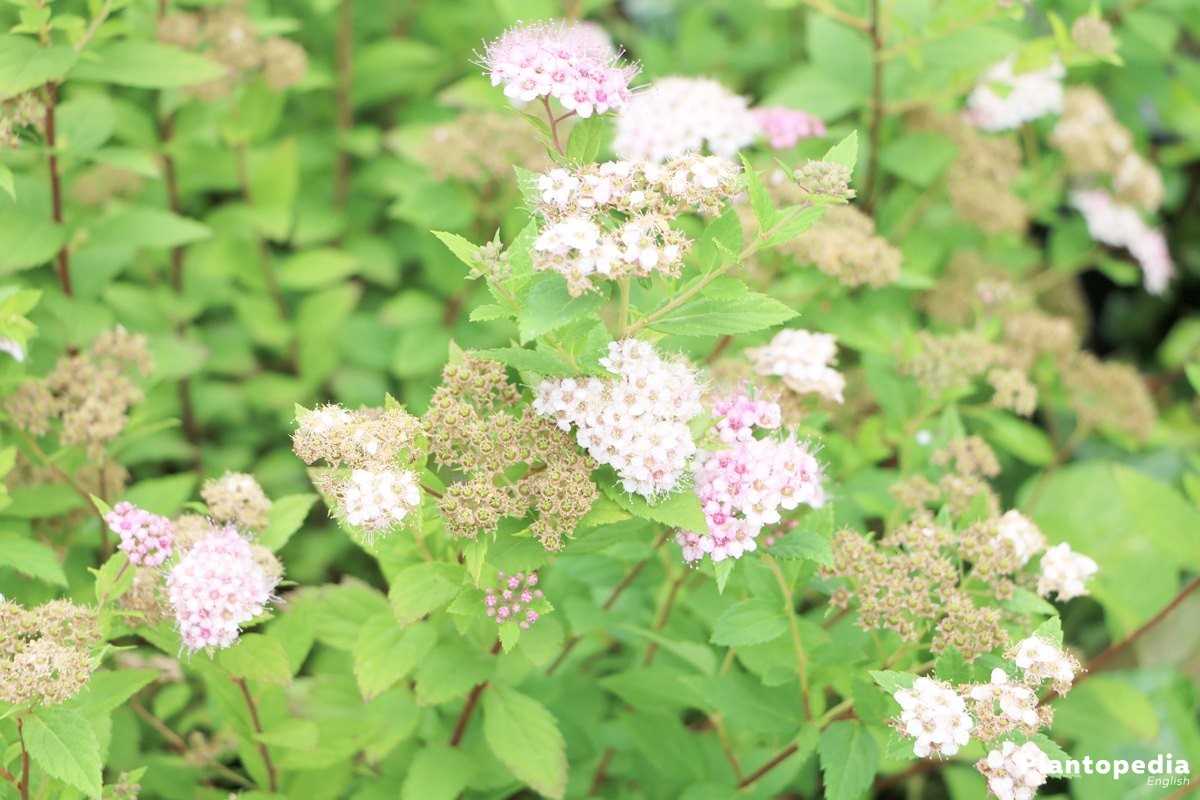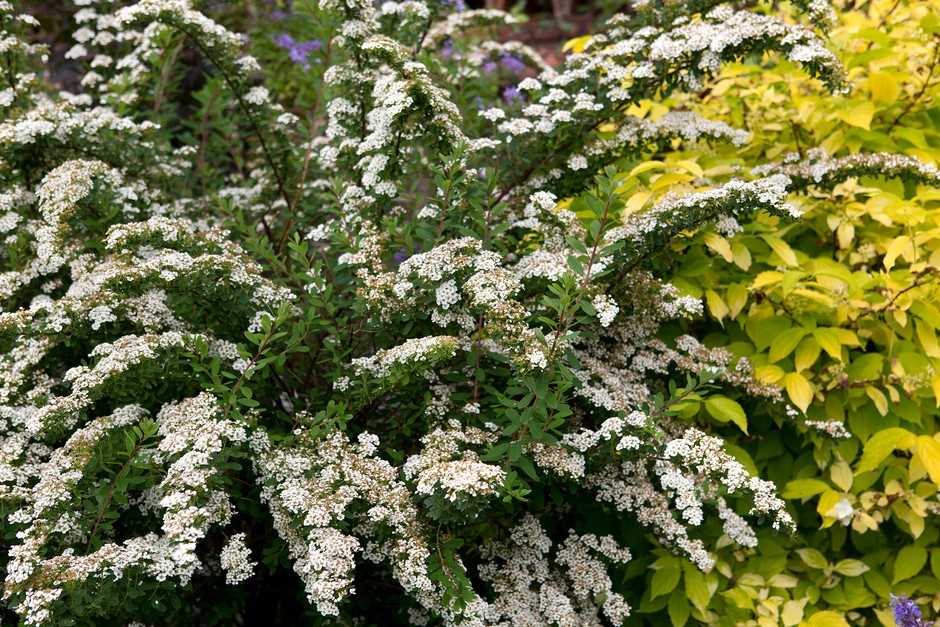- Growing Japanese Spirea: Planting and Care Guide, Varieties Description
- Planting Japanese Spirea
- Care for Japanese Spirea
- Description of Japanese Spirea Varieties
- Choosing the Right Location
- Sunlight
- Soil
- Moisture
- Climate
- Soil Preparation and Planting
- Soil Preparation:
- Planting:
- Watering and Fertilizing
- Watering
- Fertilizing
- Pruning and Shaping
- Why Prune Japanese Spirea?
- When to Prune Japanese Spirea?
- How to Prune Japanese Spirea?
- Pruning Tips
- Benefits of Pruning Japanese Spirea
- Pest and Disease Control
- Pests
- Diseases
- Popular Varieties of Japanese Spirea
- Using Japanese Spirea in Landscape Design
- 1. Mass Planting
- 2. Borders and Hedges
- 3. Container Gardening
- 4. Pollinator Gardens
- 5. Cut Flower Arrangements
- Tips for Successful Japanese Spirea Cultivation
- 1. Choosing the Right Location
- 2. Planting
- 3. Watering
- 4. Fertilizing
- 5. Pruning
- 6. Mulching
- 7. Pests and Diseases
- 8. Winter Protection
- Questions and Answers:
- What is Japanese spirea?
- How do I plant Japanese spirea?
- What are the common varieties of Japanese spirea?
- How tall does Japanese spirea grow?
- When do I prune Japanese spirea?
- How often should I water Japanese spirea?
- Can Japanese spirea be grown in containers?
- Videos: Renewal Pruning Spirea – Taming the Monster
Japanese Spirea (Spiraea japonica) is a stunning flowering shrub that is native to Japan, China, and Korea. It is beloved by gardeners for its versatility, hardiness, and beautiful flowers. Japanese Spirea is known for its cascading clusters of small, vibrant flowers that bloom in a range of colors, including pink, red, and white. This shrub is also prized for its foliage, which can be green, gold, or variegated.
When it comes to planting Japanese Spirea, it is important to choose a location that receives full to partial sun. The soil should be well-draining and fertile. Japanese Spirea can tolerate a range of soil conditions, but it thrives in soil that is rich in organic matter. Before planting, it is recommended to amend the soil with compost or well-rotted manure to improve drainage and fertility.
Once planted, Japanese Spirea requires minimal care. Regular watering is essential during the first year to help establish the roots. After that, it is relatively drought tolerant and only needs to be watered during prolonged dry spells. Pruning is another important aspect of Japanese Spirea care. It is best to prune the shrub in early spring before new growth emerges. This will help maintain its shape and promote healthy flowering.
Japanese Spirea has several popular varieties, each with its own unique characteristics. One such variety is ‘Goldflame’, which has burgundy colored foliage that matures to a gold color in the fall. Another variety is ‘Neon Flash’, which is known for its vibrant neon pink flowers. ‘Little Princess’ is a dwarf variety with pink flowers that is perfect for small gardens or containers. These are just a few examples of the wide range of Japanese Spirea varieties available to gardeners.
In conclusion, Japanese Spirea is a versatile and beautiful flowering shrub that adds color and interest to any garden. With proper planting and care, this shrub can thrive and provide years of enjoyment. Whether you choose a classic variety or one of the newer cultivars, Japanese Spirea is sure to be a stunning addition to your landscape.
Growing Japanese Spirea: Planting and Care Guide, Varieties Description
Planting Japanese Spirea
Japanese spirea is a versatile and easy-to-grow shrub that can thrive in a variety of conditions. Here are some tips for planting Japanese spirea:
- Choose a location that receives full sun to partial shade. Japanese spirea can tolerate some shade, but it will produce more flowers in full sun.
- Prepare the soil by removing any weeds or grass and loosening it with a garden fork. Japanese spirea prefers well-draining soil.
- Dig a hole that is twice as wide and just as deep as the root ball of the plant. Place the plant in the hole, making sure that the top of the root ball is level with the soil surface.
- Backfill the hole with soil, gently firming it around the roots. Water the plant thoroughly to settle the soil.
- Mulch around the base of the plant to help retain moisture and discourage weed growth.
Care for Japanese Spirea
Japanese spirea is a low-maintenance plant, but it still requires some care to keep it healthy and thriving. Here are some care tips for Japanese spirea:
- Water the plant regularly, especially during dry periods. Japanese spirea prefers consistently moist soil.
- Fertilize the plant in the spring with a balanced, slow-release fertilizer. Follow the packaging instructions for application rates.
- Prune the plant in late winter or early spring to remove any dead or damaged branches and to shape the plant. Japanese spirea can also be cut back after flowering to encourage a second flush of blooms.
- Watch out for common pests and diseases, such as aphids and powdery mildew. Treat any infestations or infections promptly.
Description of Japanese Spirea Varieties
Japanese spirea comes in a variety of cultivars, each with its own unique characteristics. Here are some popular Japanese spirea varieties:
| Variety | Description |
|---|---|
| ‘Gold Mound’ | Compact shrub with golden foliage that turns shades of orange and red in the fall. |
| ‘Little Princess’ | Small shrub with pink flowers and a compact habit. It blooms throughout the summer. |
| ‘Magic Carpet’ | Low-growing shrub with pink flowers and colorful foliage that changes from red to gold to green throughout the season. |
| ‘Neon Flash’ | Tall shrub with bright pink flowers that bloom in early summer. It has green foliage that turns burgundy in the fall. |
These are just a few examples of the many beautiful Japanese spirea varieties available. Choose the one that best suits your garden’s needs and enjoy the beauty it brings.
Choosing the Right Location
When selecting a location for your Japanese Spirea, it is important to consider the specific needs of the plant. Here are some factors to keep in mind:
Sunlight
Japanese Spirea thrives in full sun to partial shade. It is recommended to choose a location that receives at least 6 hours of direct sunlight per day. Too much shade can result in poor growth and fewer blooms.
Soil
Japanese Spirea prefers well-draining soil that is rich in organic matter. It is important to avoid locations with heavy clay soil that can retain water and cause root rot. If your soil is not ideal, you can improve drainage by adding organic amendments such as compost or peat moss.
Moisture
While Japanese Spirea is relatively tolerant of different moisture levels, it generally prefers a consistently moist soil. Avoid planting in areas that are prone to waterlogging or drought. Adequate moisture will help promote healthy growth and abundant blooms.
Climate
Japanese Spirea is adaptable to a wide range of climates, but some varieties may be more cold or heat tolerant than others. It is important to choose a variety that is well-suited to your specific climate to ensure its long-term survival and success.
| Location Considerations | Optimal Conditions |
|---|---|
| Sunlight | Full sun to partial shade |
| Soil | Well-draining, rich in organic matter |
| Moisture | Consistently moist, avoid waterlogging or drought |
| Climate | Choose variety suited to your specific climate |
By considering these factors, you can choose the right location for your Japanese Spirea to ensure optimal growth and vibrant blooms.
Soil Preparation and Planting
Before planting Japanese spirea, it is important to prepare the soil properly to ensure optimal growth and health of the plant. Here are some steps to follow:
Soil Preparation:
- Choose a well-draining location with full sun to partial shade. Japanese spirea can tolerate a wide range of soil types, but prefers moist, fertile soils.
- Clear the area of any weeds or grass. Use a garden fork or shovel to loosen the soil and remove any large rocks or debris.
- Amend the soil with organic matter such as compost or well-rotted manure. This will improve the soil structure and provide essential nutrients for the plant.
- Mix the organic matter into the top 6-8 inches of soil using a garden fork or tiller. Smooth out the soil surface with a rake.
Planting:

- Dig a hole that is slightly larger and deeper than the nursery container or root ball of the Japanese spirea.
- Remove the plant from its container and gently loosen the roots. If the plant is root-bound, you can use a knife to make a few vertical cuts on the sides of the root ball.
- Place the Japanese spirea in the hole, making sure it is level with or slightly above the surrounding soil.
- Backfill the hole with soil, firming it gently around the roots to eliminate any air pockets.
- Water the plant thoroughly after planting to settle the soil and ensure good root-to-soil contact.
Once planted, Japanese spirea should be watered regularly, especially during dry periods. Mulching around the base of the plant with organic mulch, such as wood chips or straw, will help conserve soil moisture and suppress weed growth. Pruning can be done in early spring to shape the plant and remove any dead or damaged branches.
Watering and Fertilizing
Watering and fertilizing are important aspects of growing Japanese Spirea plants. Proper watering and fertilization will help ensure the health and vitality of the plant, as well as promote optimal growth and flowering.
Watering
Japanese Spirea plants require regular watering, especially during dry periods and hot summer months. It is important to keep the soil evenly moist, but not waterlogged. Overwatering can lead to root rot and other issues.
Here are some tips for watering Japanese Spirea:
- Water the plants deeply, so that the water reaches the root zone.
- Water the plants in the morning or evening to minimize evaporation and allow the plants to absorb water effectively.
- Avoid overhead watering, as it can increase the risk of diseases.
- Monitor the moisture level of the soil and adjust the watering frequency accordingly.
Fertilizing

Japanese Spirea plants benefit from regular fertilization to provide them with essential nutrients for growth and flowering. A balanced fertilizer with a ratio of 10-10-10 or 20-20-20 is suitable for Japanese Spirea.
Here are some tips for fertilizing Japanese Spirea:
- Apply the fertilizer in early spring, before new growth begins.
- Follow the instructions on the fertilizer packaging for the recommended application rate.
- Spread the fertilizer evenly around the base of the plant, avoiding direct contact with the stems and leaves.
- Water the plant thoroughly after applying the fertilizer to ensure that it reaches the root zone.
- Repeat the fertilization process every 4 to 6 weeks during the growing season.
Regular watering and fertilizing will help keep your Japanese Spirea plants healthy and thriving, ensuring a beautiful display of blooms and foliage.
Pruning and Shaping
Why Prune Japanese Spirea?
Pruning is an essential part of maintaining the health and appearance of Japanese Spirea plants. Regular pruning helps to promote new growth, maintain a compact shape, and remove any dead or damaged branches.
When to Prune Japanese Spirea?
The best time to prune Japanese Spirea is in late winter or early spring before new growth begins. This allows the plant to recover quickly and ensures that it will bloom abundantly during the summer months. Some gardeners also choose to prune again in the late summer or early fall to remove any spent flowers and maintain the shape of the plant.
How to Prune Japanese Spirea?
Before pruning, it is important to gather the necessary tools, such as sharp pruning shears or hedge trimmers, gloves, and safety goggles. Begin by removing any dead or damaged branches, making clean cuts at a 45-degree angle just above a healthy bud or branch. Next, thin out the center of the plant by selectively removing some of the older branches to improve air circulation and allow light to reach the interior. Lastly, shape the plant by trimming back the remaining branches to the desired size and shape. Take care not to prune more than one-third of the plant at a time, as excessive pruning can weaken the plant and reduce flowering.
Pruning Tips
- Always use clean, sharp tools to avoid damaging the plant.
- Consider wearing gloves to protect your hands from thorns and goggles to protect your eyes from debris.
- Remove any suckers or unwanted shoots that may appear at the base of the plant.
- Regularly inspect the plant for signs of disease or pests and take appropriate action.
- Dispose of pruned branches properly to prevent the spread of diseases or pests.
Benefits of Pruning Japanese Spirea
Pruning Japanese Spirea offers several benefits, including:
- Promoting new growth and maintaining a compact shape.
- Removing dead or damaged branches, improving the overall health of the plant.
- Enhancing the appearance of the plant by shaping it to the desired size and form.
- Increasing air circulation and allowing more light to reach the interior of the plant, reducing the risk of disease and promoting better blooming.
- Preventing the plant from becoming overgrown and invasive.
By following proper pruning techniques and regularly maintaining your Japanese Spirea plants, you can enjoy a healthy and beautiful addition to your garden or landscape.
Pest and Disease Control
Pests
The Japanese Spirea is generally resistant to pests, but there are a few common ones to watch out for:
- Aphids: These small insects can be found on the undersides of the leaves, sucking the sap from the plant. They can be controlled by spraying the affected areas with insecticidal soap or applying neem oil.
- Spider Mites: These tiny pests can be identified by the fine webbing they create on the plant. They feed on the foliage, causing it to turn yellow or bronze. Spider mites can be controlled by regularly spraying the plant with water to increase humidity or using insecticidal soap.
- Scale Insects: These insects appear as small, immobile bumps on the stems and leaves of the Japanese Spirea. They can be controlled by manually removing them with a soft cloth or cotton swab dipped in rubbing alcohol.
Diseases
The Japanese Spirea is generally resistant to diseases, but there are a few common ones to be aware of:
- Powdery Mildew: This fungal disease appears as a white, powdery substance on the leaves and stems of the plant. It can be controlled by ensuring good air circulation around the plant and avoiding overhead watering. If necessary, fungicides can be used according to the manufacturer’s instructions.
- Rust: This fungal disease appears as orange or brown spots on the leaves and stems of the plant. It can be controlled by removing and disposing of infected plant material and applying fungicides if necessary.
- Leaf Spot: This fungal disease causes dark spots to appear on the leaves of the plant. It can be controlled by removing and disposing of infected plant material and ensuring good air circulation around the plant.
Regularly inspecting the Japanese Spirea for pests and diseases and taking appropriate action as soon as any issues are detected will help to keep the plant healthy and thriving.
Popular Varieties of Japanese Spirea
Japanese Spirea is a popular ornamental shrub, known for its beautiful flowers and foliage. There are several different varieties of Japanese Spirea, each with their own unique characteristics. Here are some of the most popular varieties:
- Goldflame: This variety of Japanese Spirea has vibrant golden foliage that emerges in the spring and matures to a greenish-yellow color. It produces clusters of pink flowers in the summer and is a compact and dense shrub.
- Little Princess: This variety is a smaller version of the Japanese Spirea with a compact and rounded shape. It has delicate pink flowers that bloom in summer and its foliage appears in a bright green color.
- Anthony Waterer: This is a popular variety of Japanese Spirea, known for its vibrant pink flower clusters. It has dark green foliage that turns to reddish-purple in the fall, providing a beautiful autumn display. It is a compact shrub that can be used as a focal point in a garden border.
- Neon Flash: With its bright pink flowers and dark green foliage, this variety adds a pop of color to any garden. It has a medium growth rate and is known for its long-lasting blooms.
In addition to these popular varieties, there are many other cultivars of Japanese Spirea available in a wide range of colors and sizes. These shrubs are versatile and can be used in various landscaping applications, such as borders, hedges, or mass plantings. They are relatively low maintenance and can tolerate a wide range of soil conditions. If you’re looking to add a splash of color and texture to your garden, Japanese Spirea is a great choice.
Using Japanese Spirea in Landscape Design
The Japanese Spirea is a popular shrub that can add beauty and versatility to any landscape design. With its beautiful blooms, vibrant foliage, and compact size, it is a great choice for adding color and texture to gardens, borders, and containers. Here are some ways you can use Japanese Spirea in your landscape design:
1. Mass Planting
Japanese Spirea is a great choice for mass plantings, as it can create a stunning visual impact. Plant them in large groups to create a sea of color in your garden. The compact size of Japanese Spirea makes it easy to create a uniform look, and it will provide a beautiful backdrop for other plants.
2. Borders and Hedges

Japanese Spirea can also be used to create borders or hedges in your garden. Plant them in a row to create a dense and attractive barrier. You can choose different varieties of Japanese Spirea to create a colorful and dynamic hedge. The dense foliage of Japanese Spirea will also provide privacy and protection.
3. Container Gardening
If you have limited space or want to add color to your patio or balcony, Japanese Spirea is a great choice for container gardening. You can use it as a focal point in a container or combine it with other plants for a beautiful display. The compact size of Japanese Spirea makes it easy to fit in a container, and it will bloom for a long time with proper care.
4. Pollinator Gardens
Japanese Spirea is attractive to bees, butterflies, and other pollinators, making it a great addition to a pollinator garden. Planting Japanese Spirea will not only provide nectar and pollen for pollinators but will also attract them to your garden. This can help promote biodiversity and contribute to the health of the ecosystem.
5. Cut Flower Arrangements
The beautiful blooms of Japanese Spirea make it a great choice for cut flower arrangements. Cut the flowers just as they begin to open, and they will last longer in a vase. Use them to create beautiful bouquets or add a pop of color to floral arrangements.
In conclusion, Japanese Spirea is a versatile shrub that can be used in various ways in landscape design. Whether you choose to use it for mass plantings, borders and hedges, container gardening, pollinator gardens, or cut flower arrangements, Japanese Spirea will add beauty and color to your outdoor space.
Tips for Successful Japanese Spirea Cultivation

1. Choosing the Right Location
Japanese spirea thrives in full sun to partial shade, so choose a location with at least 4 to 6 hours of direct sunlight each day. The soil should be well-draining, moist, and rich in organic matter. Avoid planting in low-lying areas that are prone to waterlogging.
2. Planting
Dig a hole that is twice as wide and slightly deeper than the root ball of the spirea plant. Place the plant in the hole, making sure that the crown is level with or slightly above the soil surface. Backfill the hole with soil, firming it gently around the roots. Water thoroughly after planting.
3. Watering
Water newly planted Japanese spirea regularly to keep the soil consistently moist, but not waterlogged. Established plants generally only need watering during dry periods. Avoid overwatering, as this can lead to root rot.
4. Fertilizing
Japanese spirea plants generally don’t require much fertilization. However, you can apply a balanced, slow-release fertilizer in early spring if desired. Follow the instructions on the fertilizer package for dosage and application.
5. Pruning
Pruning is essential for maintaining the shape and size of Japanese spirea plants. After flowering in late spring or early summer, prune back one-third of the oldest stems to the ground to rejuvenate the plant. This will encourage new growth and enhance flowering. Regularly remove any dead or damaged branches throughout the year.
6. Mulching
Applying a layer of organic mulch, such as wood chips or compost, around the base of Japanese spirea plants can help conserve moisture, suppress weeds, and improve soil fertility. Spread the mulch in a 2 to 3-inch layer, taking care not to pile it up against the plant’s stem.
7. Pests and Diseases
Japanese spirea is generally resistant to pests and diseases. However, it can occasionally be affected by aphids or powdery mildew. Monitor the plants regularly and take appropriate actions if any issues arise. In case of severe infestation or disease, consult with a local plant specialist or extension service for guidance.
8. Winter Protection
Japanese spirea plants are generally hardy and can withstand cold temperatures. However, in areas with severe winters, it may be necessary to protect the plant by mulching the base with straw or covering it with burlap.
By following these tips for successful Japanese spirea cultivation, you can enjoy the beauty of these plants in your garden for years to come.
Questions and Answers:
What is Japanese spirea?
Japanese spirea, or Spiraea japonica, is a flowering shrub native to Japan. It is known for its beautiful clusters of flowers and attractive foliage.
How do I plant Japanese spirea?
To plant Japanese spirea, choose a location with well-drained soil and full sun or partial shade. Dig a hole twice as wide and just as deep as the root ball. Place the plant in the hole and backfill with soil, firming it gently. Water the plant thoroughly after planting.
What are the common varieties of Japanese spirea?
Some common varieties of Japanese spirea include ‘Goldflame’, which has golden foliage that turns red in the fall, ‘Neon Flash’, which has bright pink flowers, and ‘Little Princess’, which is a compact plant with pink flowers.
How tall does Japanese spirea grow?
Japanese spirea typically grows to a height of 2 to 3 feet, but some varieties can grow up to 5 feet tall.
When do I prune Japanese spirea?
Japanese spirea should be pruned in the late winter or early spring before new growth starts. You can remove dead or damaged branches, as well as shape the plant to maintain its desired size and form.
How often should I water Japanese spirea?
Japanese spirea should be watered regularly, especially during periods of drought. Water deeply once or twice a week, allowing the soil to dry slightly between waterings. Avoid overwatering, as it can lead to root rot.
Can Japanese spirea be grown in containers?
Yes, Japanese spirea can be grown in containers. Choose a large container with drainage holes and fill it with well-draining potting soil. Place the plant in the container and water it thoroughly. Place the container in a location that receives full sun or partial shade. Water the plant regularly and fertilize it every few weeks during the growing season.







